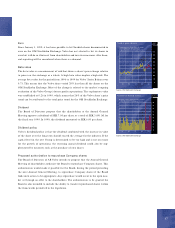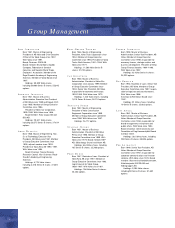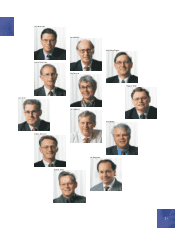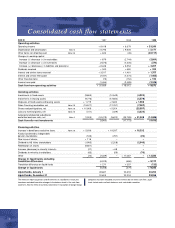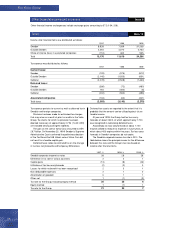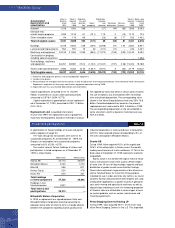Volvo 1999 Annual Report Download - page 59
Download and view the complete annual report
Please find page 59 of the 1999 Volvo annual report below. You can navigate through the pages in the report by either clicking on the pages listed below, or by using the keyword search tool below to find specific information within the annual report.
57
Amounts in SEK M unless otherwise specified. The amounts within parentheses refer to the two preceding years; the
first figure is for 1998 and the second for 1997.
principle. At January 1, 1997, 1998 and 1999, this
resulted in an increase in The Volvo Group’s share-
holders’ equity of SEK 1.4, 1.5 and 1.3 billion, respecti-
vely.
Cash flow statement
In 1999, Volvo’s cash flow statement analysis is present-
ed in accordance with the Swedish Financial Accounting
Standards Council’s recommendation, Cash Flow Account-
ing, RR7. Comparable figures for 1997 and 1998 were
restated to conform with the 1999 presentation.
Consolidated accounts
The consolidated accounts comprise the Parent Company,
all subsidiaries and associated companies. Subsidiaries
are defined as companies in which Volvo holds more
than 50% of the voting rights or in which Volvo other-
wise has a controlling influence. However, subsidiaries in
which Volvo’s holding is temporary are not consolidated.
Associated companies are companies in which Volvo has
long-term holdings equal to at least 20% but not more
than 50% of the voting rights.
The consolidated accounts are prepared in accord-
ance with the principles set forth in the Recommenda-
tion of the Swedish Financial Accounting Standards
Council, Consolidated Accounting RR1:96.
All acquisitions of companies are accounted for in
accordance with the purchase method.
Companies that have been divested are normally
included in the consolidated accounts up to and including
the date of divestment. However the measurement date
for divestment of Volvo Cars is January 1, 1999. Companies
acquired during the year are consolidated as of the date
of acquisition.
Holdings in associated companies are reported in
accordance with the equity method. The Group’s share
of reported income before taxes in such companies,
adjusted for minority interests, is included in the consoli-
dated income statement in Income from investments in
associated companies, reduced in appropriate cases by
amortization of goodwill. An amortization period of 20
years is applied for goodwill attributable to Volvo’s hold-
ing in Scania. The Group’s share of reported taxes in
associated companies, is included in Group tax expense.
For practical reasons, most of the associated com-
panies are included in the consolidated accounts with
a certain time lag, normally one quarter. Dividends from
associated companies are not included in consolidated
income. In the consolidated balance sheet, the book
value of shareholdings in associated companies is affect-
ed by Volvo’s share of the company’s income after tax,
reduced by the amortization of goodwill and by the
amount of dividends received.
Volvo’s operations
Considering the prevailing competitive situation and the
ongoing consolidation in the transport vehicle industry,
Volvo chose in the beginning of 1999 to divest Volvo
Cars to Ford Motor Company. Consequently, Volvo’s op-
erations are now concentrated in commercial vehicles
and service with the aim of further developing its market
positions in trucks, buses, construction equipment, en-
gines for marine and industrial applications and engine
components and service for the aerospace industry.
Operating structure
The Volvo Group’s operations during 1999 were organ-
ized in five product-related business areas: Trucks,
Buses, Construction Equipment, Marine and Industrial
Engines, and Aero. In addition to the five business areas,
there are certain operations consisting mainly of service
companies that are designed to support the other busi-
ness areas’ operations.
Each business area has total responsibility for its
operating income and operating capital. In 1999, business
area responsibilities included responsibility for sales-
financing activities, but certain restrictions and principles
were established centrally.
The supervision and coordination of treasury and tax
matters is organized centrally to obtain the benefits of
a Groupwide approach.
The legal structure of the Volvo Group is based on
optimal handling of treasury, tax and administrative mat-
ters and, accordingly, differs from the operating structure.
The consolidated financial statements for AB Volvo (the
Parent Company) and its subsidiaries are prepared in
accordance with Swedish GAAP. These accounting prin-
ciples differ in significant respects from U.S. GAAP, see
Note 33.
Changes in accounting principles
Income taxes
Effective in 1999, Volvo adopted the Swedish Financial
Accounting Standards Councils Recommendation,
Income Taxes, RR9, which in all significant respects
corresponds with the International Accounting Standard
Committee’s (IASC’s) recommendation, Income Taxes,
IAS 12 (revised 1996). Volvo formerly recognized de-
ferred tax assets pertaining to temporary differences, as
well as tax loss carryforwards, to the degree that these
items could be netted against deferred tax liabilities in
the same tax jurisdiction. Effective in 1999, deferred tax
assets are recognized, provided that it is probable that
the amounts can be utilized in connection with future
taxable income. The comparable figures for 1997 and
1998 have been restated to reflect the new accounting
Accounting principles Note 1
Notes to consolidated financial statements


